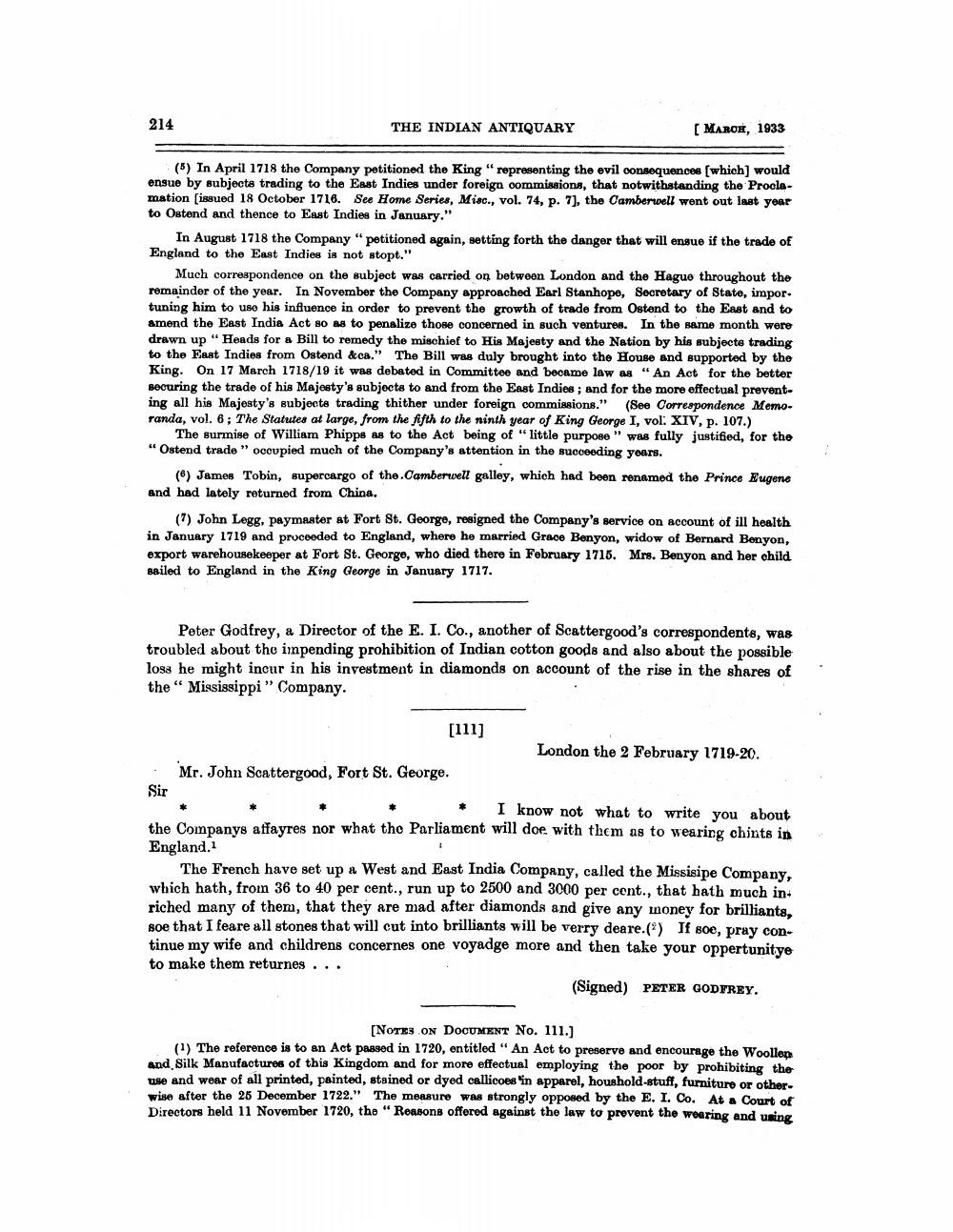________________
214
THE INDIAN ANTIQUARY
[MARCH, 1933
(5) In April 1718 the Company petitioned the King "representing the evil consequences [which] would ensue by subjects trading to the East Indies under foreign commissions, that notwithstanding the Proclamation [issued 18 October 1716. See Home Series, Misc., vol. 74, p. 7], the Camberwell went out last year to Ostend and thence to East Indies in January."
In August 1718 the Company "petitioned again, setting forth the danger that will ensue if the trade of England to the East Indies is not stopt."
Much correspondence on the subject was carried on between London and the Hague throughout the remainder of the year. In November the Company approached Earl Stanhope, Secretary of State, importuning him to use his influence in order to prevent the growth of trade from Ostend to the East and to amend the East India Act so as to penalize those concerned in such ventures. In the same month were drawn up "Heads for a Bill to remedy the mischief to His Majesty and the Nation by his subjects trading to the East Indies from Ostend &ca." The Bill was duly brought into the House and supported by the King. On 17 March 1718/19 it was debated in Committee and became law as "An Act for the better securing the trade of his Majesty's subjects to and from the East Indies; and for the more effectual preventing all his Majesty's subjects trading thither under foreign commissions." (See Correspondence Memoranda, vol. 6; The Statutes at large, from the fifth to the ninth year of King George I, vol: XIV, p. 107.)
The surmise of William Phipps as to the Act being of "little purpose" was fully justified, for the "Ostend trade" occupied much of the Company's attention in the succeeding years.
(6) James Tobin, supercargo of the Camberwell galley, which had been renamed the Prince Eugene and had lately returned from China.
(7) John Legg, paymaster at Fort St. George, resigned the Company's service on account of ill health in January 1719 and proceeded to England, where he married Grace Benyon, widow of Bernard Benyon, export warehousekeeper at Fort St. George, who died there in February 1715. Mrs. Benyon and her child sailed to England in the King George in January 1717.
Peter Godfrey, a Director of the E. I. Co., another of Scattergood's correspondents, was troubled about the impending prohibition of Indian cotton goods and also about the possible loss he might incur in his investment in diamonds on account of the rise in the shares of the "Mississippi" Company.
[111]
Mr. John Scattergood, Fort St. George.
London the 2 February 1719-20.
Sir
I know not what to write you about the Companys affayres nor what the Parliament will doe with them as to wearing chints in England.
The French have set up a West and East India Company, called the Missisipe Company, which hath, from 36 to 40 per cent., run up to 2500 and 3000 per cent., that hath much in riched many of them, that they are mad after diamonds and give any money for brilliants, soe that I feare all stones that will cut into brilliants will be verry deare.(2) If soe, pray continue my wife and childrens concernes one voyadge more and then take your oppertunitye to make them returnes...
(Signed) PETER GODFREY.
[NOTES ON DOCUMENT No. 111.]
(1) The reference is to an Act passed in 1720, entitled "An Act to preserve and encourage the Woollen and Silk Manufactures of this Kingdom and for more effectual employing the poor by prohibiting the use and wear of all printed, painted, stained or dyed callicoes 'in apparel, houshold-stuff, furniture or otherwise after the 25 December 1722." The measure was strongly opposed by the E. I. Co. At a Court of Directors held 11 November 1720, the "Reasons offered against the law to prevent the wearing and using




